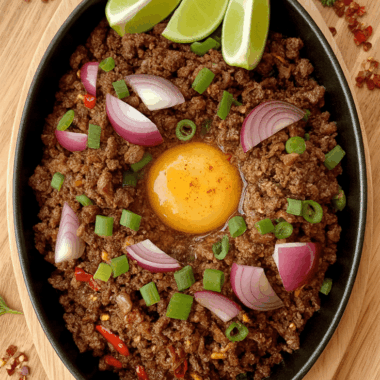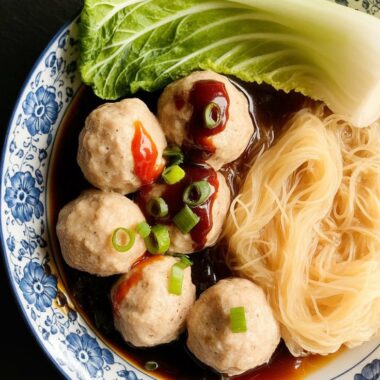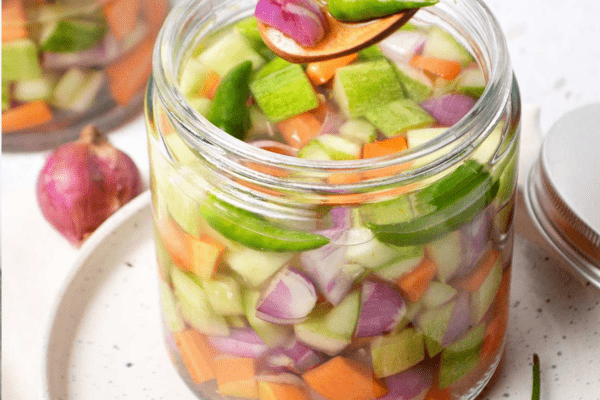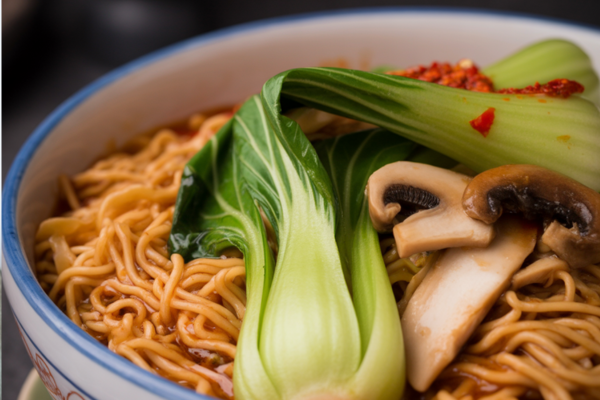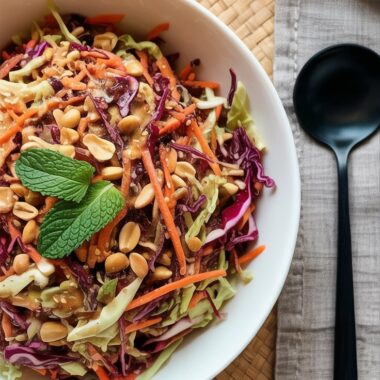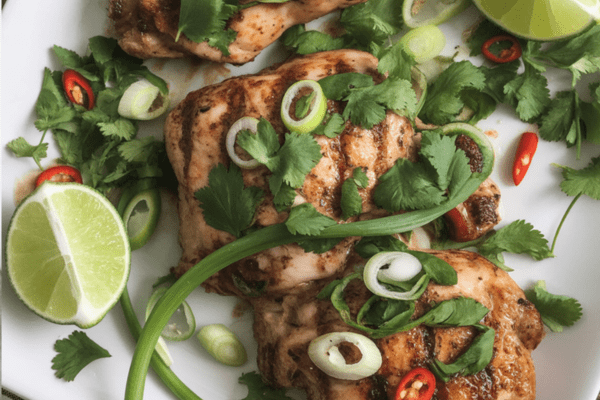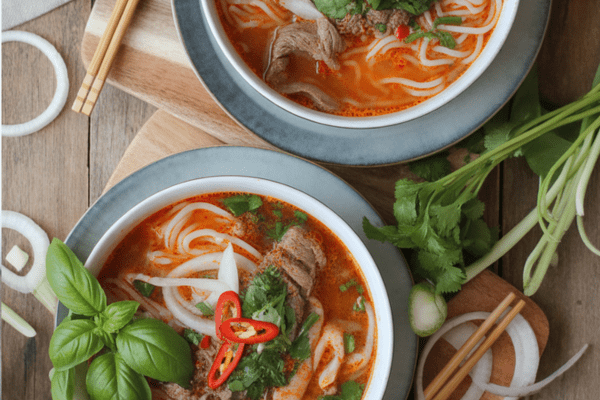After years of experimenting in my kitchen, I always come back to this rich, nutty, deeply flavored Malaysian-style satay sauce. It’s one of those sauces that makes you stop mid-bite and just appreciate how balanced it is. The lemongrass, ginger, galangal, and toasted peanuts come together beautifully, with just enough heat to keep you reaching for more.

I use it constantly with grilled chicken skewers, but honestly, I’ll even slather it on leftover roast veggies. I’ve simplified the recipe so anyone can make it at home, even if you don’t have access to fancy specialty ingredients.
Malaysian vs. Thai Peanut Sauces: My Take
Growing up loving both, I’ve cooked and eaten my fair share of satay sauces. I always explain to friends that Malaysian versions tend to be more herbal, with plenty of lemongrass, ginger, galangal, and coriander seed. Thai sauces lean on red curry paste and usually have more coconut milk, making them a bit richer and creamier in a different way.
When I want something with big, bold, slightly spicy, peanutty flavor that doesn’t feel too heavy, I make this Malaysian-style one.
Why I Always Make This Satay Sauce at Home
I started making this because good Malaysian food is almost impossible to find in my area. I missed the flavors so much that I decided to figure it out for myself.
This sauce takes me straight back to afternoons grilling satay over charcoal, dipping it into a warm bowl of sauce that was equal parts nutty, herbal, sweet, and spicy.
What I love about my home version:
- Real flavors, simplified process – I want to keep it authentic without spending hours dry-toasting peanuts and peeling them. Store-bought toasted peanuts work just fine.
- Flexible heat – Add more chilies for kick or tone it down for the kids.
- Big batch-friendly – I make double and freeze it in flat bags for quick meals later.

Ingredients I Always Keep Around
Here’s what I use in my kitchen—and a few real-life tips about each:
Chilies – Fresh chilies are my shortcut. Dried ones need soaking and take longer. When I’m feeling lazy or cooking for the family on a weeknight, I go fresh. I like bird’s eye chilies if I want serious heat.
Lemongrass – This is non-negotiable for that unmistakable Malaysian flavor. I buy frozen lemongrass stalks from the Asian store. They last forever in the freezer.
Galangal – Has that slightly piney, citrusy kick that ginger alone can’t replicate. But if I’m out of it, I just use extra ginger and call it a day.
Peanuts – I always have unsalted toasted peanuts for snacking, and they’re perfect here. No need to dry-toast, cool, peel, and grind from scratch.
Concentrated tamarind – A little goes a long way for brightness. If I run out, lime juice is an easy substitute.
Fish sauce and soy sauce – These replace the traditional dried shrimp that’s hard to find where I live. The mix brings deep, savory notes without needing specialty ingredients.

How I Actually Make It at Home
Here’s the process I use whenever I whip up a batch.
Step 1: Prep the Peanuts
I use my blender to pulse them into a semi-fine texture. Don’t over-blend or you’ll end up with peanut butter. I like small chunks for texture.
If I happen to dry-toast my own peanuts (usually only when I’m trying to impress someone), I let them cool completely before blending so they don’t clump.
Step 2: Blend the Base
I throw lemongrass, galangal, ginger, onion, garlic, chilies, and coriander seeds into a mini-chopper. This paste is where the magic happens—it’s deeply aromatic.
Step 3: Cook the Paste
I bruise a lemongrass stalk with my rolling pin and fry it gently in oil until fragrant. Then I add the paste and cook it down until the oil separates. This step is key.
When the oil starts pooling on top, I know it’s ready. It’s an old trick I picked up from watching aunties cook curries.
Step 4: Finish the Sauce
I stir in the blended peanuts, coconut milk, coconut sugar, tamarind, water, fish sauce, soy sauce, and salt. Bring it all to a gentle boil, then simmer for 10 minutes until the oil splits again. The sauce turns glossy and thick.
My Best Kitchen Tips for This Sauce
Here are the practical things I always do to get this right every time:
- Let peanuts cool completely if you’re toasting them yourself—they’ll blend better and stay crunchy.
- Pulse peanuts in small batches to get even texture without making paste.
- Don’t rush cooking the paste—waiting for the oil to separate is what builds the deep, layered flavor.
- I always use a splatter guard. This sauce loves to spit when it bubbles. My poor stove has suffered for my satay experiments.
How I Use, Store, and Freeze It
Serving Ideas
My favorite is classic grilled chicken satay skewers. But I’ve also used it as a sauce for grilled pork chops, roasted veggies, and even leftover rice bowls. It has a way of making anything taste special.
Storing
I keep it in an airtight container in the fridge for up to a week. It thickens a bit, but that’s normal.
Freezing
I freeze it in flat ziplock bags so I can break off a piece as needed. It thaws quickly that way. I’ve kept it for up to six months in the freezer without losing flavor.
Reheating
When reheating, I add a splash of water to loosen it up and adjust the salt if needed. I do this on the stove over low heat.
Authentic Malaysian Satay Sauce

If there’s one condiment that can elevate grilled meats or veggies to another level, it’s this Malaysian-style satay sauce.
Ingredients
Fragrant Base
- 2 tablespoons coriander seeds
- 4 red chilies, sliced (adjust to taste)
- ½ red onion, sliced
- 3 stalks lemongrass (white part only), thinly sliced
- 4 garlic cloves
- 1-inch piece ginger, sliced
- 1-inch piece galangal, sliced
Main Components
- 1 lemongrass stalk (whole, white part only – for cooking)
- ⅓ cup (65 g) coconut oil (or your preferred oil)
- 1 cup (150 g) plain roasted peanuts
- ½ cup (120 g) coconut milk
- 1½ cups (345 g) water
- ¼ cup (40 g) coconut sugar (or brown sugar)
- 2 tablespoons low-sodium soy sauce
- 1 tablespoon fish sauce
- 1 tablespoon tamarind concentrate (or lime juice)
- ½ teaspoon salt (or to taste)
Instructions
- Prepare the Peanuts: If using store-bought roasted peanuts, grind them into a semi-fine texture in small batches using a food processor or grinder. Want to roast your own? You’ve got options:
- Pan Method: Dry-toast on medium heat for 20–30 minutes, stirring occasionally.
- Oven Method: Spread on a tray and bake at 320ºF (160ºC) for 20–30 minutes.
- Air Fryer Method: Cook at 320ºF (160ºC) for 15–20 minutes, shaking once halfway through.
- Once cooled, remove the skins by rubbing the peanuts with a kitchen towel. Grind to a coarse or semi-fine texture – aim for a bit of crunch!
- Blend the Spice Base: In a food processor or chopper, combine chilies, coriander seeds, onion, garlic, lemongrass slices, ginger, and galangal. Process until a smooth paste forms.
- Cook the Sauce: Lightly bruise a whole lemongrass stalk and add it to a pot with the coconut oil. Heat until the oil begins to sizzle gently. Stir in the spice paste and sauté over medium heat until it thickens and the oil begins to separate – this takes about 5 to 10 minutes. Be patient; this step builds flavor!
- Add the ground peanuts, coconut milk, tamarind, water, coconut sugar, soy sauce, fish sauce, and salt. Stir well and bring to a boil. Reduce the heat and let it simmer uncovered for around 10 minutes, until the sauce thickens and the oil rises to the top – a sign that it's perfectly cooked.
Notes
- Cool the peanuts before blending – warm peanuts can turn into peanut butter instead of a coarse grind.
- Grind in batches – this ensures a consistent texture throughout.
- Don’t skip the "oil separation" step – it’s the key to unlocking authentic flavor.
- Use a splatter guard during simmering – things can get messy when the sauce bubbles up!
Nutrition Information:
Yield: 2 Serving Size: 1Amount Per Serving: Calories: 311Total Fat: 6gSaturated Fat: 1gTrans Fat: 0gUnsaturated Fat: 4gCholesterol: 5mgSodium: 1813mgCarbohydrates: 64gFiber: 5gSugar: 12gProtein: 10g
Asianplated.com, occasionally offers nutritional information for recipes contained on this site. This information is provided as a courtesy and is an estimate only. This information comes from online calculators. Although allchickenrecipes.com attempts to provide accurate nutritional information, these figures are only estimates.
Common Questions I Get
Is satay sauce the same as peanut sauce?
Sort of. Satay sauce is a type of peanut sauce but with specific Southeast Asian flavors—like lemongrass, galangal, and tamarind—designed to go with skewered grilled meats.
Can I skip the fish sauce?
If you can’t use fish sauce, add a bit more soy sauce with a squeeze of lime juice. It won’t be quite the same, but it will still be delicious.
If you’re craving that authentic, aromatic, nutty Malaysian satay experience at home, this is the recipe that always does it for me. Hope it becomes one of those sauces you’ll want to keep in the fridge at all times too.
Try other Malaysian recipes:







